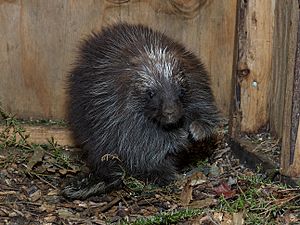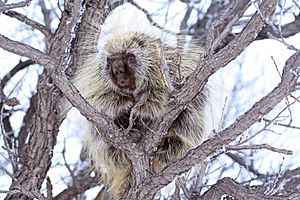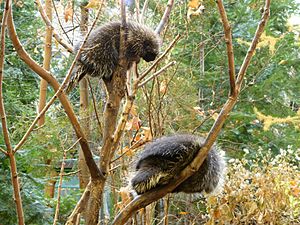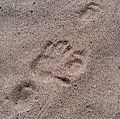North American porcupine facts for kids
Quick facts for kids North American porcupineTemporal range: Pleistocene - Recent
|
|
|---|---|
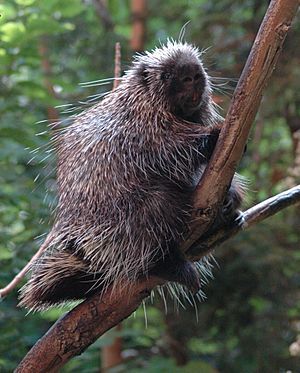 |
|
| Conservation status | |
| Scientific classification | |
| Genus: |
Erethizon
|
| Species: |
dorsatum
|
| Subspecies | |
|
|
| Synonyms | |
|
Erethizon dorsatus |
|
The North American porcupine (Erethizon dorsatum), also called the Canadian porcupine, is a big rodent. It belongs to the New World porcupine family. This animal is the second largest rodent in North America. Only the North American beaver is bigger. Porcupines came from South America. Their ancestors traveled from Africa to Brazil about 30 million years ago. Later, they moved to North America. This happened when the Isthmus of Panama formed.
Contents
What's in a Name?
The word "porcupine" comes from an old French word. Porcespin means "thorn pig." This name combines the Latin words porcus (pig) and spina (thorns). People sometimes call them "quill pigs." They are also known as Canadian porcupines. The scientific name, Erethizon dorsatum, means "the animal with the irritating back." Native American names for it include pahin (Lakota) and waxąhį (Ho-Chunk).
Porcupine Family Tree
The North American porcupine came from South America. All New World porcupines developed there. Erethizon appeared in North America after the two continents connected. This happened a long time ago. Other similar animals also moved north. But Erethizon was the only one to survive north of Mexico. The oldest known porcupine fossils are from the Pleistocene era. They were found in Mexico.
Types of Porcupines
There are seven types, or subspecies, of E. dorsatum. They live in different areas across North America. The most common type is E. d. dorsatum. It lives from Nova Scotia to Alberta. It also ranges from Virginia to the Yukon. Other types live in specific regions. For example, E. d. picinum lives in Quebec and Labrador. E. d. couesi is found in Mexico and Colorado.
How to Spot a Porcupine
Porcupines are usually dark brown or black. They often have white spots or highlights. They have a strong body and a small face. Their legs are short, and their tail is thick. This species is the biggest New World porcupine. It is one of North America's largest rodents. Only the American beaver is larger.
Their body length is about 60 to 90 centimeters (2 to 3 feet). Their tail adds another 14.5 to 30 centimeters (6 to 12 inches). An adult porcupine can weigh from 3.5 to 18 kilograms (8 to 40 pounds). Females usually weigh around 7 kg (15 lb). Wild males can average about 10.67 kg (23.5 lb).
Porcupines are the only native North American mammal with natural antibiotics in their skin. These help prevent infection. This is useful if they fall from a tree. They might get stuck by their own quills when they hit the ground. Porcupines fall often because they love eating tasty buds and twigs.
Amazing Quills
The porcupine's most special feature is its quills. An adult porcupine has about 30,000 quills. They cover most of its body. Only its belly, face, and feet are bare. Quills are like modified hairs. They are sharp, hollow spines with barbs.
Porcupines use quills mainly for defense. They also help keep them warm in winter. Porcupines do not throw their quills. When they feel threatened, they tighten their skin muscles. This makes the quills stand up and stick out. In this position, quills can easily detach. If a porcupine swings its tail, quills can get stuck in an attacker. The barbs make them hard and painful to remove. Normally, quills lie flat against the body.
Warning Scent
The North American porcupine has a strong smell. This odor warns away predators. The smell gets stronger when the porcupine is upset. People have described it as similar to strong human body odor. It can also smell like goats or some cheeses. This smell comes from a special skin patch. It is on their lower back.
Where Porcupines Live
In eastern North America, porcupines live from Canada. They go down to the Appalachian Mountains. In the west, they live from Alaska to northern Mexico. They usually live in forests with pine trees. They also live in mixed forests. But they can live in tough places too. This includes shrublands and cold, treeless tundras. They make their homes in hollow trees or rocky spots.
Porcupine Habits
What Porcupines Eat
In summer, porcupines eat twigs, roots, and berries. They also eat other plants. In winter, they mostly eat pine needles and tree bark. Porcupines are picky eaters. For example, in some areas, they might only eat a few specific trees.
Daily Life and Behavior
Porcupines are nearsighted and move slowly. They are mostly active at night. During summer days, they often rest in trees. They do not hibernate in winter. Instead, they stay close to their dens. They are solitary animals. This means they live alone. This is different from many plant-eating animals. Those animals often live in groups. Porcupines are also very smart. They can learn complex mazes. They remember them for a long time.
How Porcupines Defend Themselves
The North American porcupine has special ways to warn or defend itself. It uses a strong warning smell. This smell gets stronger when it is upset. When threatened, an adult porcupine raises its quills. This shows a white stripe down its back. It also makes a clacking sound with its teeth.
If these warnings don't work, it uses its quills. An adult porcupine turns its back to a predator. If approached, it can swing its tail. The quills easily stick into an attacker's skin. Each quill has tiny barbs. These barbs help it stay stuck. This defense works well against most attacks. An attacker with a face full of quills usually runs away. The porcupine's last defense is to climb a tree.
Who Hunts Porcupines?
Animals that hunt porcupines include fishers, wolverines, coyotes, wolves, black bears, and cougars. Humans also hunt them. Birds like golden eagles and great horned owls hunt them too. Sometimes, predators get hurt or even die from porcupine quills.
The fisher is a big threat to porcupines. Fishers are related to weasels. They are good at climbing trees. If a fisher finds a porcupine, it can chase it up a tree. Then it forces the porcupine down to the ground. On the ground, the porcupine tries to show its quilled back. But the fisher is fast. It bites the porcupine's face. After many bites, the porcupine gets weak. The fisher can then flip it over. It attacks the porcupine's soft belly to kill it.
Another strong predator is the cougar. Cougars don't worry about quills. They can tolerate many quills stuck in their gums. Cougars can climb trees. They like to knock the porcupine to the ground. There, they quickly kill it. Other predators, like wild dogs, might attack. But they are not as big a threat. Sometimes, porcupine quills have killed cougars. This usually happens after the cougar has eaten the porcupine.
Porcupine Life Cycle
Reproduction
Female porcupines live alone most of the year. This changes during fall, when breeding season starts. Females release a special scent. This smell attracts males nearby. The first male to arrive usually waits below the female in the same tree. If another male comes, they might fight to mate.
Once a male wins, he sprays urine on the female. Just a few drops touch her. This chemical reaction helps the female get ready to mate. After this, mating happens on the ground. When porcupines mate, they tighten their skin. They hold their quills flat. This prevents them from hurting each other. They may mate many times. Then the female loses interest and climbs back into the tree.
North American porcupines have a long pregnancy. It lasts for 202 days. For comparison, a beaver's pregnancy is 128 days. A squirrel's is only 44 days. Porcupines usually give birth to one baby. At birth, babies weigh about 450 grams (1 pound). They grow to almost 1 kg (2.2 pounds) in two weeks. They reach full adult weight around 4.5 kg (10 pounds) by their second summer. Their quills harden soon after birth.
Female porcupines care for their young alone. For the first two weeks, babies rely on their mother for food. After that, they learn to climb trees and find food. They continue to nurse for up to four months. This is around the fall mating season. They stay close to their mothers. Mother porcupines do not defend their young. But they have been known to care for them even after death. In one case, a mother stayed by her baby's side for hours after it fell from a tree. She waited for it to revive.
Life Expectancy
North American porcupines live for a long time. Some have lived up to 30 years. They often die from being hunted or from starvation. They can also die from falling out of trees. Many are also hit by cars on roads.
Porcupines and People
Some people see porcupines as a pest. This is because they can damage trees. They also chew on wooden and leather items. Plywood is especially attractive to them. This is due to salts added during its making.
Native Americans use porcupine quills. They decorate baskets and clothing with them. Porcupines were also an important food source. This was especially true in winter for people in Canada's northern forests. Porcupines move slowly. They are often hit by cars when crossing roads.
Backpackers know porcupines love salt. They might eat boots left outside tents overnight. These boots often have road salt on them. Forestry workers also know this. Porcupines try to eat their sweaty gloves. They also chew on tool handles covered in sweat.
Conservation Status
Globally, the North American porcupine is not in danger. It is listed as a species of least concern. It is common across most of its range. But in some U.S. states in the southeast, it needs protection. For example, it is a species in need of conservation in Maryland. In Mexico, there are only small groups left. They live in forests and grasslands. They are threatened by hunting and losing their homes. In 1994, it was listed as an endangered species in Mexico.
Images for kids
-
Bark of sugar maple eaten by a porcupine
See also
 In Spanish: Ursón para niños
In Spanish: Ursón para niños



